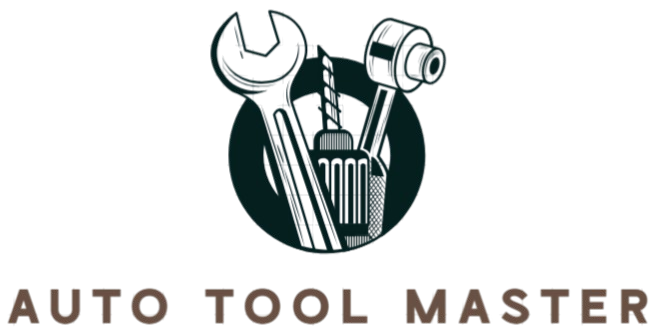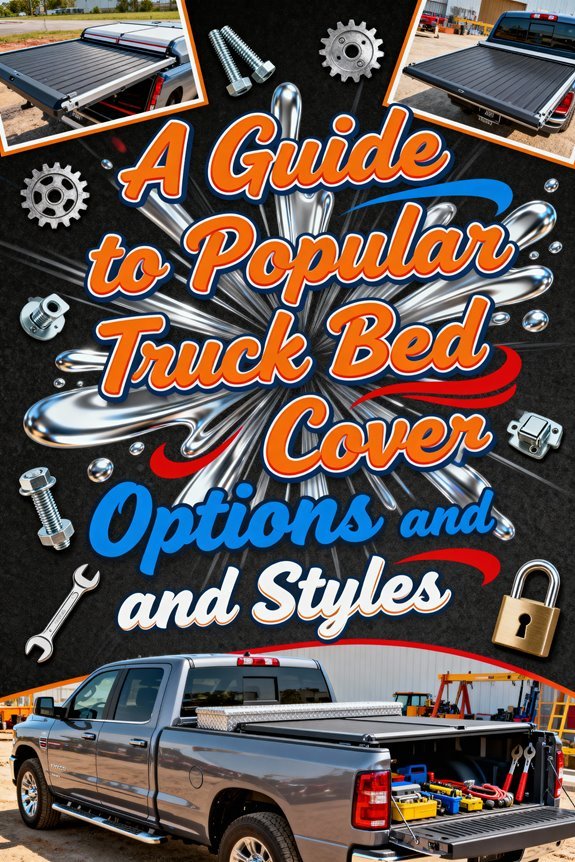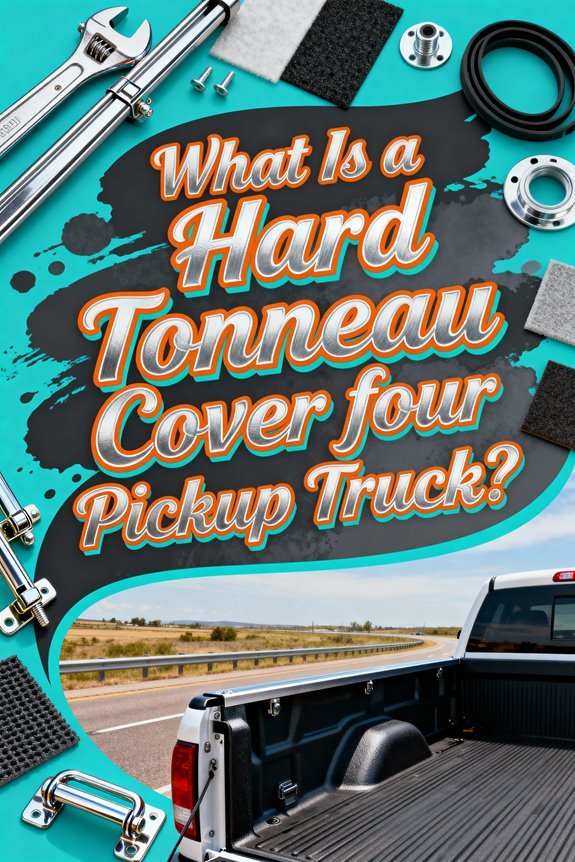Start by gathering your tools—½-inch ratchet, Phillips screwdriver, and torque wrench—then clean your truck bed rails with rubbing alcohol. Position the side rails with mounting brackets fully forward, insert clamps 6-9 inches from each end, and torque them to 10 ft/lbs. Unfold the cover panels toward the tailgate, align mounting holes with slotted brackets, and secure loosely. Install cab bumpers and drain hoses, then perform final tightening while checking seal contact points. The following detailed steps will guarantee proper alignment and watertight performance.
Gather Your Tools and Prepare Your Workspace
Before beginning your tonneau cover installation, you’ll need five essential tools: a ratchet with ½-inch socket for tightening clamps to the specified 10 ft/lbs torque, a Phillips head screwdriver for securing buckle ends and cab bumpers, scissors for trimming adhesive-backed seals, a rubber mallet for panel adjustments, and optionally a torque wrench for precise clamp tensioning.
Proper workspace cleanliness is critical for successful installation. Thoroughly clean your truck bed rails, bulkhead, and bed caps, then wipe all surfaces with rubbing alcohol to remove oils and debris that could compromise adhesive bonding. Work in a dry, temperature-controlled environment on level ground to guarantee proper rail alignment and panel seating.
Implement effective tool organization by laying out all hardware, clamps, seals, and cover panels before starting. Label components by installation step to streamline your workflow and prevent assembly errors. Handle all parts carefully during the process to avoid damage and ensure optimal fit throughout installation. When positioning components, ensure you maintain serial number visibility throughout the installation process to avoid covering essential product information. During the installation, verify that all side rails are correctly positioned to ensure proper alignment and functionality of your tonneau cover.
Inspect Your BAKFlip Cover Components
Once you’ve prepared your workspace, open the BAKFlip packaging and systematically verify all major components against the manufacturer’s packing list. Component verification begins with inspecting each panel for dents, scratches, or deformities affecting fold operation. Examine side rails and front hinge rail for bends or misalignment with mounting points. Locate prop rods and confirm their support mechanisms function correctly.
Conduct thorough seal inspection by examining weather seals for cracks, tears, or dryness. Verify the bulkhead seal measures approximately 65 inches with 3/4-inch thickness. Check adhesive backing integrity on all seals. Inventory hardware—bolts, nuts, washers, knob kits—against the installation list. Ensure you have specialized rubber tailgate seals to block out dust and water intrusion around the tailgate area. If your BAKFlip VP was manufactured before April 2016, verify whether you have D-rings or the updated buckles and straps for security. Test fold joints, locking levers, and hinge operation for smooth movement. Quality tonneau covers should include security locks to protect your cargo from theft. Document any damaged or missing components before proceeding with installation.
Position and Secure the Rails to Your Truck Bed
Start rail installation by placing both side rails onto the truck bed with their silver mounting brackets positioned fully forward and centered along each bed rail. The front rail should sit just inside the bulkhead, allowing the panel seal to rest on top for proper sealing. Confirm precise rail alignment by positioning rails parallel to bed edges before securing.
For clamp positioning on 8-foot beds, place the first clamp 6-9 inches from the front, with the rear clamp approximately 6 inches from the tailgate. Space additional clamps evenly along each rail. Insert clamps into the rail slots, ensuring teeth align appropriately for proper engagement. Assemble washers beneath each clamp bolt: rubber washer, flat washer, lock washer, then finger knob. Apply downward pressure while tightening clamps to achieve flush contact, torquing to 10 ft/lbs for secure mounting and watertight seal integrity. BAKFlip covers feature easy installation that typically doesn’t require professional assistance, making them accessible for do-it-yourself truck owners. These hard folding covers provide superior security and weather resistance compared to soft roll-up alternatives, protecting your truck bed investment with durable aluminum or composite construction.
Assemble and Align the Cover Panels
Position the cover with the small front panel facing the cab of the truck to establish proper orientation before placement. Place the folded cover on top of the rails so this panel aligns at the front near the cab bulkhead. The seal should rest on top of the rail to create a proper seal. Fold the first panel down over the silver brackets attached to the side rails.
Unfold the cover toward the tailgate while ensuring panel alignment fits squarely between the side rails. The aluminum frame requires approximately 1/4 inch clearance inside the tailgate. Insert large flat bolts through pre-drilled holes, then assemble washers underneath: rubber washer, large flat stainless washer, lock washer, and 5-star finger knob. Loosely tighten knobs initially to allow cover adjustment before final securing. Carefully align the cover components to ensure smooth operation of the folding mechanism throughout its range of motion.
Once the cover is in position, center cover over rails and latch it into place to verify proper alignment before making final adjustments. With proper preparation and following the manufacturer’s instructions, the installation process is generally straightforward and efficient.
Attach the Cover to the Rail Brackets
Align the mounting holes on the cover panels with the silver slotted brackets attached to the side rails, making certain the folded cover rests squarely across both rails. Position the panels in their folded configuration with the small panel forward toward the cab. The seal on the front panel must rest atop the bulkhead rail for proper cover alignment and watertight performance.
Fold the cover down over the silver brackets, securing it to the rail system. Verify that all mounting points engage correctly with the slotted brackets. This step establishes the foundation for clamp installation and guarantees the cover operates smoothly throughout its range of motion. The click-in design eliminates the need for cutting, trimming, or drilling during installation.
Check that the cover sits flush across both rails before proceeding to final clamp tightening procedures. Proper installation ensures enhanced security and protection for your truck bed cargo. The entire installation process typically requires only basic tools such as hex keys and screwdrivers to complete.
Install Cab Bumpers and Drain Hoses
Three cab bumpers protect your truck’s rear glass from contact with the tonneau cover during operation. Position these bumpers along the top edge of the cover where it meets the cab. No tools are required—simply align them to guarantee proper cab bumper alignment and prevent scratches to your glass.
Next, attach the black drain tubes to their designated mounting points. Route these hoses to direct water flow away from the truck bed, preventing accumulation that could damage your cargo. If necessary, use a utility knife to cut out the plastic plugs before connecting the drain tubing to the fittings. Proper installation guarantees best drainage performance throughout the cover’s lifespan.
Regular drain hose maintenance is essential for system longevity. Check hoses periodically for blockages or clogs that could impair water evacuation. Clean any obstructions immediately to maintain peak performance and protect your truck bed investment. Before proceeding, clean the truck bed to ensure proper adhesion and fit of all components. Ensuring a weather-tight fit helps safeguard your cargo from moisture and the elements.
Set Up Prop Rods and Adjust Seals
Once your cab bumpers and drain hoses are installed, you’ll configure the prop rod system to support the tonneau cover in its open position. Lift the cover past 90 degrees toward the cab, then release the prop rod from its storage attachment on the rail. Position the rod firmly against the vertical plate on the cover’s underside. Slide the prop rod locks downward and tighten the knobs to secure both sides. Confirm there’s minimal movement once locked. For proper prop rod operation, always return rods to their storage position when not in use.
Next, align the seals on the bulkhead rail. Apply downward pressure while tightening clamps to guarantee flush contact. The EPDM rubber seals provide reliable weatherproofing to protect your truck bed from the elements. Regular seal maintenance requires inspecting for debris and cleaning to maintain effectiveness. When installing the bulkhead seal, peel tape back in increments to prevent stretching the seal material during application. Like other quality covers such as those from Gator Tonneau, proper installation ensures maximum weather resistance and long-term durability.
Perform Final Tightening and Adjustments
With all components positioned, you’ll begin the critical torque phase by tightening each clamp incrementally across both bed rails. First, snug all clamps hand-tight, then apply a half turn to achieve approximately 10 ft/lbs torque specifications per clamp. Position your first and rear clamps 6 to 9 inches from the bulkhead and tailgate respectively. Apply downward pressure on rails while tightening to guarantee flush contact and proper seal integrity. Close the cover slowly, observing edges for uneven gaps or overhangs. If misalignment occurs, loosen clamps slightly, reposition for uniform spacing, then retighten. Pull or push panels laterally as needed for precise alignment. Verify the cover closes smoothly and locks without binding. Inspect all seals for gaps or pinches, confirming watertight integrity before final verification. Proper installation and sealing can contribute to improved fuel efficiency by reducing wind drag in your truck bed. While professional installation typically involves basic tools and takes a few hours, following these adjustment steps carefully ensures proper performance. Plan to perform additional adjustments after the cover has settled over time to maintain optimal performance.
Test Cover Operation and Watertight Seal
After completing torque specifications and alignment checks, you’ll verify operational functionality through systematic testing procedures. Open and close each panel sequentially, confirming all latches engage completely with side rails and panels rest flat against the bed surface. Inspect the front panel’s position inside the bulkhead rail, confirming the seal contacts the rail top. Verify the aluminum frame sits inside the tailgate with the flap seal resting atop it. Check C-clamp tightness and confirm rails sit flush without gaps. Test folding configurations using prop rods and securing straps to validate cover functionality. Inspect front drain hoses for proper attachment to factory bed plugs. Execute sealing efficiency verification by checking panel alignment and seal contact points across all surfaces to ascertain watertight integrity. Similar to tightening bolts to specified torque on ladder rack installations, proper fastener tension ensures your tonneau cover maintains structural integrity and sealing performance. A properly installed tonneau cover improves fuel efficiency by minimizing aerodynamic drag over your truck bed during highway operation.


